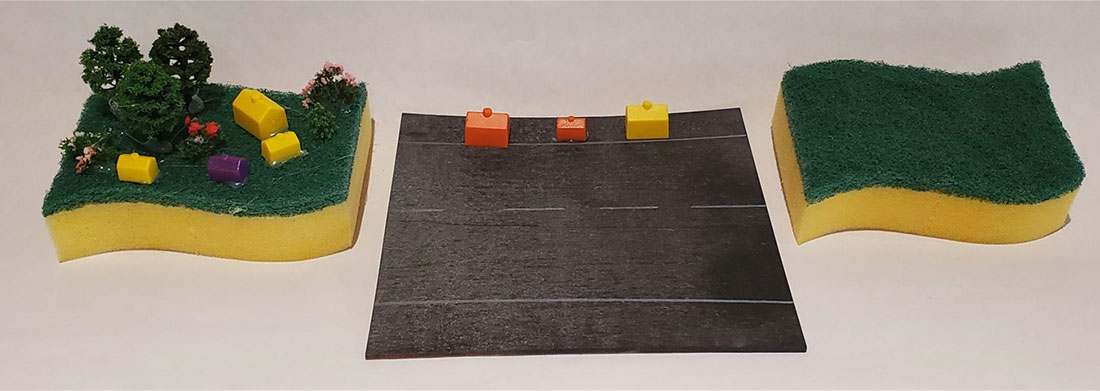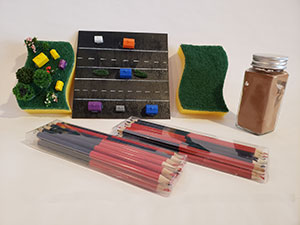Lesson 3: Walk Around the Schoolyard
In this lesson, we will explore how the surface cover of the land impacts where the water goes when it rains by identifying pervious and impervious surfaces in our schoolyard. Next time there is a heavy rainstorm, look out the window and watch where the water goes. If there is a heavy rainstorm while you are at school, be a careful observer and watch where the water travels after it hits the ground. For example, is there an area in the parking lot where puddles form, or does a small "river" of water run across the outdoor basketball court? Many built surfaces are quite impervious to rainwater. Impervious means that liquid cannot pass through, and an impervious surface is any solid surface that will not allow water to penetrate. Impervious surfaces are constructed to make life easier. As a society, we rely on roads, parking lots, sidewalks, buildings, basketball courts, etc., but these impervious surfaces also contribute to various problems, including increased runoff and pollution. When rain falls on impervious surfaces, instead of soaking into the ground and replenishing the groundwater, the rain runs over impervious surfaces, picking up sediment and pollution, which can quickly end up in our local streams and rivers. When water runs over the surface instead of infiltrating into the ground, we call this runoff. An increase in runoff can also lead to increased flooding as more water goes to the stream instead of infiltrating into the ground; this can erode stream banks and harm the organisms that live in the stream.
Materials:
Materials provided in the Lesson 3 kit:
- Activity 1: Pervious/Impervious Demo- Tray & spray bottle, sponge meadow model, sponge town model, paved road model, and a small container of cocoa powder.
- Activity 2: 25 blue-colored pencils, 25 red-colored pencils,
Materials you will need to gather:
- Lesson 3 slide show
- Activity 1: Tray and spray bottle (use a tray and spray bottle from lesson 2 kit), water pitcher
- Activity 2: 25 copies of your schoolyard map (e.g., Millersville University).
- Activity 2: 25 clipboards or something hard to write on when walking outside.
Learning Objectives:
At the completion of the lesson, students will be able to:
- Describe the impact of impervious surfaces on where the water goes when it rains.
- Identify pervious and impervious surfaces in their schoolyard.
Activities:
This lesson begins with demonstrating pervious and impervious surfaces. Before the class, you will need the three models from your kit. To start, show the lesson 3 PowerPoint and the slide with the image of a meadow. Then, take the green and yellow sponge and tell them that this is our model of a meadow. Ask students where does the water go when it rains in a meadow? Probe student thinking and work to get to the idea that water seeps into the ground (use the term - infiltration). Use a spray bottle to make it rain on the sponge. The water infiltrates into the ground because the ground is a pervious surface. This is good because water infiltrates into the ground and replenishes our groundwater. This process means our water wells won't run dry!

Next, show students the sponge town and paved road model. (Show the image from the PowerPoint of the meadow, the town, and the urban city.) The sponge town represents a town with many green spaces, and the paved road represents a town with an area with lots of pavements and few green spaces. What happens if it rains in the town versus the paved road in the urban city? Make it rain on each model. The goal is to help students understand that green spaces are pervious surfaces where water can seep into the ground. Parking lots, roads, and roofs are impervious surfaces, and water cannot pass through impervious surfaces. Water that falls on impervious surfaces runs off the surface into the nearest stream.
Now sprinkle the Cocoa powder on both models. Explain that the Cocoa powder represents pollution, such as oil dripping from cars, fertilizer, trash, etc. What happens to this pollution when it rains on pervious versus impervious surfaces? Make it rain on each model. (Hold the models at a slight angle so the water flows off the surface of the impervious model.) Students will see from the model that the water picks up the pollution and runs off along the surface. Connect this back to the crumpled watershed activity from lesson 2. Where did all the water end up in our model watershed? It runs along the surface and can end up in our rivers or streams!
Possible Adaptations:
If you have access to one, this activity can be completed using an Enviroscape model.
In this activity, you will lead students on an outdoor tour of their schoolyard. During the walk, you and the students will identify areas of impervious and pervious surfaces.
Provide each student with a schoolyard map (create a schoolyard map using the default view on Google Maps), and a red and blue colored pencil. Project a satellite view of your schoolyard from Google Maps to help students orient themselves. On their maps, have students sketch and label main features such as the property boundary, playground, baseball field, parking lot, etc.

Satellite View

Default View
Take the students outside and start the tour. Instruct them to color the impervious areas on their maps in red and the pervious areas in blue. Encourage students to think about what happens to water when it rains on each type of surface. Explain that water will infiltrate the ground on pervious surfaces, which helps reduce flooding and replenish our groundwater. On impervious surfaces, water will runoff along the surface. Check for storm drains near these impervious surfaces, as they are installed to manage runoff. Depending on the landscape, highlight other features in the schoolyard that impact runoff. For example, sewers, rain gardens, water retention basins, etc., might be identified on the map.
Possible Differentiation Adaptations:
For activity 2, some students might struggle to connect their physical surroundings to the line drawing on the provided map. To assist these students, consider giving them a color satellite image of the map. This color version of the map can help them identify their "place" on the map and make distinguishing between pervious and impervious spaces easier.
Possible Extension:
You can also ask your school’s facilities manager to tag along on the tour to serve as an expert who can talk about how the school property is intentionally designed to manage stormwater.
Assessment:
When you return to the classroom, ask students to answer the following prompts on the back of their map.
- Make a list of the impervious and pervious surfaces you found in your schoolyard.
- When water falls on your schoolyard, does it mostly infiltrate or runoff? Use the map you created to support your answer.
*Use this assessment and a completed schoolyard map to create an anchor chart summarizing students' learning.
Reading Connection:
Nagelhout, R., 2014. Saving the Chesapeake Bay. 1st ed. New York: Gareth Stevens Publishing.

